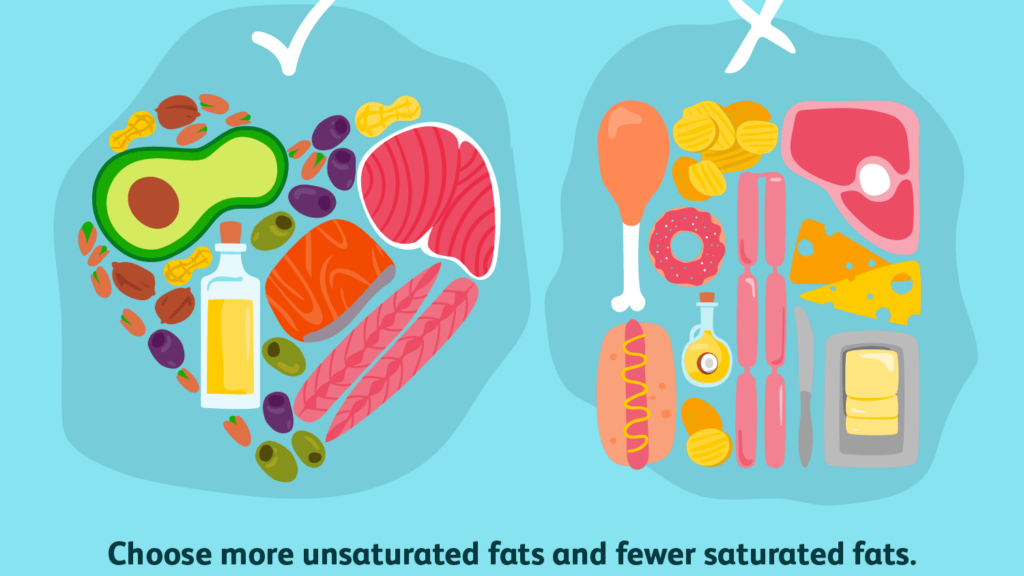Saturated Fat Versus Unsaturated Fat
Have you ever wondered what makes a fat saturated versus unsaturated (no, it's not the water content)? Or why some fats are better for you than other fats? Or why trans fat gets such a bad rap? Or, how much fat we can safely consume each day? If your answer is "yes" to any of these questions, this comparison between saturated and unsaturated fats - the two main types of dietary fat - should prove enlightening.
Saturated Fat
Saturated fat is a type of fat that is typically solid at room temperature. The name derives from the fact that the fat molecule's carbon atoms are fully saturated with hydrogen atoms - that is, as many hydrogen atoms as possible are bonded to the carbon atoms. Saturated fats comes mainly from animal products such as butter, cheese, eggs, whole milk, ice cream, cream, and fatty meats but they are also found in plant-based products such as cocoa butter, coconut oil, palm oil, and palm kernel oil.
Unsaturated Fat
Unsaturated fats are typically liquid at room temperature and are less stable than saturated or trans fats. They are derived from fish, nuts, seeds, and plant-based oils. An unsaturated fat contains one or more double bonds between adjoining carbon atoms. Where such bonds occur, hydrogen atoms are eliminated and therefore the fat is "not saturated" with hydrogen atoms. Monounsaturated fats contain just one (mono) double bond, while polyunsaturated fatty acids contain two or more (poly) double bonds. Monounsaturated fat food sources include avocados, canola oil, olives, olive oil, nuts, and peanut oil. Polyunsaturated fats are found in corn, cottonseed, safflower, sesame, and soybean oils.
Trans fat is formed by adding hydrogen to an unsaturated fat through a process called hydrogenation, resulting in a fat that is solid at room temperature with a chemical structure similar to that of a saturated fat. Small amounts also occur naturally in beef and dairy foods. Trans fats are used extensively in commercial food manufacturing to add taste and texture to foods and to extend their shelf life. If a product label states “hydrogenated oil” or “partially hydrogenated oil”, this likely means that it contains trans fats. Trans fats are found in fried foods, baked goods (donuts, cookies, crackers), margarine, and numerous processed foods.
Health Considerations
When it comes to a healthy diet, not all fats are created equal. Generally speaking, the worst offenders are fats that are solid at room temperature, namely saturated and trans fats. Saturated fat raises total blood cholesterol levels and low-density lipoprotein (LDL) cholesterol levels, increasing the risk of cardiovascular disease. It may also increase the risk of type 2 diabetes. Trans fats likewise raises "bad" (LDL) cholesterol levels but it also lowers "good" (HDL) cholesterol. Many health professionals consider trans fat to be the worst type of fat especially given how widely it is used in commercial food production.

Although still high in calories, unsaturated fats - both monounsaturated and polyunsaturated - lower blood cholesterol levels, which can decrease your risk of heart disease. They may also help decrease the risk of type 2 diabetes. One type of polyunsaturated fat, omega-3 fatty acids, may be especially beneficial to your heart in terms of decreasing the risk of coronary artery disease. Good sources of omega-3 fatty acids include cold-water fatty fish, flax seed, soy, and walnuts.
Dietary Recommendations
The American Heart Association advises limiting total fat intake to less than 25–35 percent of your total calories each day. Saturated fat intake should be less than 7% of daily calories and trans fat intake less than 1%. The remaining fat should come from sources of monounsaturated and polyunsaturated fats such as nuts, seeds, fish and vegetable oils.
Related Content: